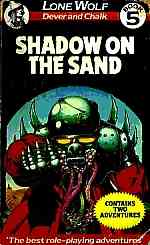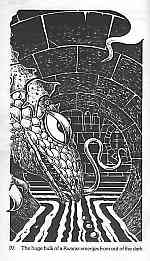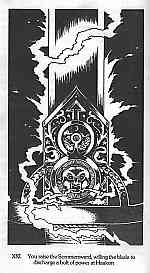
Main Page
 Main Page |
The Kai Monastery |
Those are the parting words of King Ulnar to Lone Wolf as the King sends the last of the Kai on a
diplomatic mission to the desert empire of Vassagonia. Yet, as soon as Lone Wolf arrives in
Barrakeesh, all is not what it seems.
Shadow on the Sand is one of the finest Lone Wolf books in part because of its multiplicity
of settings. Some of the adventure is urban, some of it is overland, some of it is subterranean. The
adventure is characterized more by the atmosphere of Vassagonia itself, one of foreign intrigue,
rather than the geographical surroundings. The book introduces the recurring foe Zakhan Kimah
and also marks the return of Banedon to the Lone Wolf adventures.
First published in 1985, the book is unique among the Lone Wolf adventures as the only book with
more than 350 passages. Shadow on the Sand contains 400 passages divided into two
sections of 200 each. It is, in effect, two adventures. Later books claimed on the bottom of the front
cover that Lone Wolf won the gamebook of the year award in 1985, 1986 and 1987. I don't know
who presented that award, but I bet Shadow on the Sand was the 1985 winner. The book's
cover was redone for subsequent printings by Beaver books after the switch from Sparrow. For
more details on the publishing history, see The Caverns of
Kalte.
The book also introduces the lamentable practice of including small generic illustrations throughout
the body of the book, instead of the particular illustrations which were in the earlier books. Whereas
certain passages in The Caverns of Kalte or The Chasm of Doom would contain small illustrations in the text to
show some unique item or event, all the small illustrations in Shadow on the Sand are
generic and bear no relation to the passage they appear in. This unfortunate habit is continued until
book 17 when some illustrations relating to specific passages appear again.
The story in Shadow on the Sand is always changing. That is its greatest strength. In The
Story So Far, it is commented that your "skills are better suited to the field of battle than to
parleying with foreign envoys." Yet upon arriving in Vassagonia, all thoughts of parleying are left
far behind. The story quickly becomes a chase, and from here you have many options. You can get
captured, in which case the story becomes an escape, or you can shrug off your pursuers, in which
case the story becomes a quest for a route back home. Either way, the story changes again, first into
an escape from Barrakeesh and later into a quest for the Book of the Magnakai. Shadow on the
Sand is like a play with many acts and it is fun to read just to watch the action.
The scenes in Shadow on the Sand make reading the book equally worthwhile. The details
of the Vassagonian capital, from the market quarter, to the sewers, to the baths, to the palace, are all
richly crafted. Because of them Vassagonia seems among the most real of the settings Lone Wolf
ever visits. We learn not just which way the streets turn, so we can run down them, but also the
attitude of the inhabitants to the new Zakhan, the particulars of local custom from the public baths to
the gruesome Square of the Dead and we see the Zakhan's palace in detail right down to the
Sommlending Oak in the arboretum.
It seems that Joe had not yet worked out all the details of Magnamund by the time of writing
Shadow on the Sand. The Book of the Magnakai is never mentioned before this book,
though it is obviously a vitally important element of the Lone Wolf story and of Sommlending
legend. Also, the book mentions that Sun Eagle instilled the disciplines of the Kai into the House of
Ulnar. Yet nowhere else in the books is a link made between the royal house and the Kai.
Importantly though, the "rules" set out in Shadow on the Sand are never altered with great
surprises in later books. The Book of the Magnakai is the last rabbit out of the hat as it were, the
world is complete and it is now time for the Magnakai and later the Grandmaster adventures.
The gaming elements of Shadow on the Sand also move in the direction of the later
adventures. The use of random numbers modified by disciplines to complete tasks is more prevalent
in this book than in any before it. The references to Kai Rank are more numerous than in The Chasm of Doom.
Not enough good can be said about Shadow on the Sand. It is a perfect example of most
things good about the Lone Wolf series. It shows the world of Magnamund, in this case the desert
realm of Vassagonia, in all its splendor. Its story is on a grand scale, where the future of the Kai
order and all of Magnamund are at stake. It completes the refinement of the gaming conventions
introduced in books 3 and 4. This book ends the first series of Lone Wolf adventures in wonderful
style and it sets the stage for the greater stories that will follow.
Another mistake in Shadow on the Sand occurs when getting the itikar from its pen. In
order to reach the pen you must pass a sentry. You can use Mind Over Matter to untie his money
pouch, or you can sneak up on him. Yet, if you sneak up on him as perfectly as possible, the
passage you turn to reads as though you had untied his money pouch. Oops.
The only other error in the book is in Banedon's introduction to you. If you have the Crystal Star
Pendant, he is supposed to recognize you, and you him. However, if you take longer than four
rounds defeating the Drakkar which is attacking him, he introduces himself as a stranger regardless
of the Crystal Star Pendant. That's a minor point though.




 "I have no liking for
this desert realm, Lone Wolf, but I like the prospect of war even less. The Zakhan is old and frail,
and has no son to claim his throne when he dies. Barraka was but one of many ruthless nobles who
wait like jackals for the chance to seize power, and I fear they grow too impatient to allow the
Zakhan to die a natural death . . . . Go to Vassagonia, Lone Wolf. Sign the treaty and return
quickly. Even with the promise of peace, I fear the shadow of war will fall upon us before the year
is out."
"I have no liking for
this desert realm, Lone Wolf, but I like the prospect of war even less. The Zakhan is old and frail,
and has no son to claim his throne when he dies. Barraka was but one of many ruthless nobles who
wait like jackals for the chance to seize power, and I fear they grow too impatient to allow the
Zakhan to die a natural death . . . . Go to Vassagonia, Lone Wolf. Sign the treaty and return
quickly. Even with the promise of peace, I fear the shadow of war will fall upon us before the year
is out." Shadow on the Sand has one of the best story lines of any Lone Wolf book. The key feature
is the mystery, the lack of a specific objective from the beginning of the book. It also has a richness
of texture and detail that is unsurpassed in any subsequent book. It is good that this particular book
is blessed with these attributes, since as the introduction to the Magnakai series, Shadow on the
Sand stands at a crucial point in the Lone Wolf saga. With this book Joe Dever seems to perfect
the form of his Lone Wolf books and finish crafting the world of Magnamund. Now the stage is set
for greater adventures.
Shadow on the Sand has one of the best story lines of any Lone Wolf book. The key feature
is the mystery, the lack of a specific objective from the beginning of the book. It also has a richness
of texture and detail that is unsurpassed in any subsequent book. It is good that this particular book
is blessed with these attributes, since as the introduction to the Magnakai series, Shadow on the
Sand stands at a crucial point in the Lone Wolf saga. With this book Joe Dever seems to perfect
the form of his Lone Wolf books and finish crafting the world of Magnamund. Now the stage is set
for greater adventures. The depth of the setting extends to the second
part of the book where we see the Koos and the town of Ikaresh. But the second half of the book is
marked more by the extreme importance of the quest. The Book of the Magnakai makes possibile
the Magnakai adventures which follow. The heroic vision of a new order of Kai warriors
encourages you to complete the story. The book itself is the final chapter in Lone Wolf's
advancement to the rank of Master. If Shadow on the Sand did not present this crucial quest
wrapped in an exciting plot with fine detail, then the overall story of Lone Wolf would be weakened
considerably. As it is, because the book succeeds as a standalone adventure, it makes this part of the
Lone Wolf saga one of the richest of the years MS 5050 to MS 5081.
The depth of the setting extends to the second
part of the book where we see the Koos and the town of Ikaresh. But the second half of the book is
marked more by the extreme importance of the quest. The Book of the Magnakai makes possibile
the Magnakai adventures which follow. The heroic vision of a new order of Kai warriors
encourages you to complete the story. The book itself is the final chapter in Lone Wolf's
advancement to the rank of Master. If Shadow on the Sand did not present this crucial quest
wrapped in an exciting plot with fine detail, then the overall story of Lone Wolf would be weakened
considerably. As it is, because the book succeeds as a standalone adventure, it makes this part of the
Lone Wolf saga one of the richest of the years MS 5050 to MS 5081. Despite its strengths, Shadow on the Sand is not without its mistakes. The mention of Sun
Eagle instilling the Kai disciplines into the House of Ulnar seems very strange. If this is meant to
explain how King Ulnar I could have wielded the Sommerswerd in battle with Vashna (when the
Sommerswerd is said to be a weapon only for a Kai) it fails. Sun Eagle did not complete his own
quest for the Lorestones until after the Battle of Maakengorge so that still leaves Ulnar's use of the
Sommerswerd as something of a mystery. Personally, I can write it off as divine right. He is the
King of the land of the sun. The sun god Kai no doubt has given certain rights and privilages to the
monarchs of his land. Still, the matter of the Kai Disciplines being instilled into the bloodline of the
Sommlending Kings remains. It is especially strange when you consider that there is no mention of
the royal house training at the Monastery. And, if the royal line are all Kai, then Lone Wolf is not
the last of the Kai. I think this statement in book 5 is the last of Joe's slipups during the intial phase
of developing Magnamund. It reminds me of the statement in Fire
on the Water that the Sommerswerd was made by a race that men would now call gods.
Despite its strengths, Shadow on the Sand is not without its mistakes. The mention of Sun
Eagle instilling the Kai disciplines into the House of Ulnar seems very strange. If this is meant to
explain how King Ulnar I could have wielded the Sommerswerd in battle with Vashna (when the
Sommerswerd is said to be a weapon only for a Kai) it fails. Sun Eagle did not complete his own
quest for the Lorestones until after the Battle of Maakengorge so that still leaves Ulnar's use of the
Sommerswerd as something of a mystery. Personally, I can write it off as divine right. He is the
King of the land of the sun. The sun god Kai no doubt has given certain rights and privilages to the
monarchs of his land. Still, the matter of the Kai Disciplines being instilled into the bloodline of the
Sommlending Kings remains. It is especially strange when you consider that there is no mention of
the royal house training at the Monastery. And, if the royal line are all Kai, then Lone Wolf is not
the last of the Kai. I think this statement in book 5 is the last of Joe's slipups during the intial phase
of developing Magnamund. It reminds me of the statement in Fire
on the Water that the Sommerswerd was made by a race that men would now call gods.
© Julian Egelstaff 1997-2000
Lone Wolf © TM Joe Dever 1984-2000